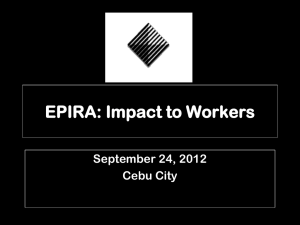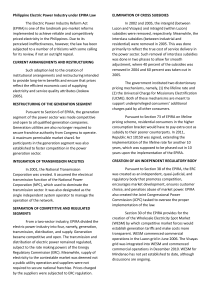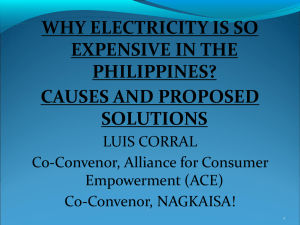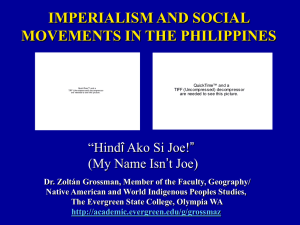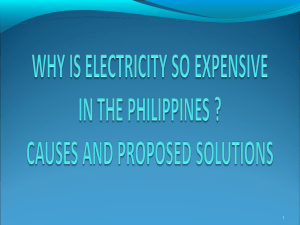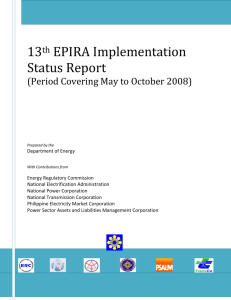Philippine Electric Power Industry Supply Security and Policy
advertisement
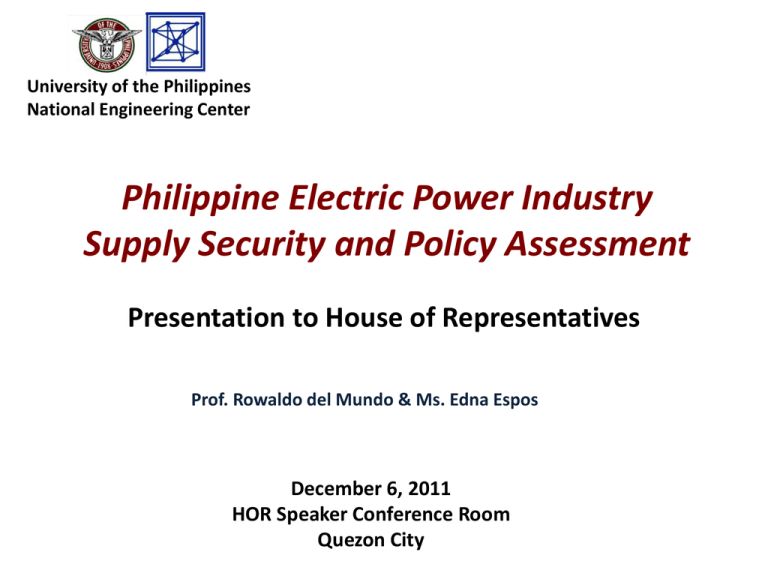
University of the Philippines National Engineering Center Philippine Electric Power Industry Supply Security and Policy Assessment Presentation to House of Representatives Prof. Rowaldo del Mundo & Ms. Edna Espos December 6, 2011 HOR Speaker Conference Room Quezon City Analysis of Supply and Demand and Reform Proposals Analysis of Supply and Demand Reliability Performance of Luzon Grid • Generation deficiency started in 2010 • There will be generation deficiency even with BacMan rehabilitation and GNPower new 600 MW Power plant in 2012 and 2013 Supply Adequacy from Pre-EPIRA IPP Program Required Reserve to meet 1 day/year LOLE = 28.7% LOLE - Probabilistic Expectation of Generation Deficiency due to simultaneous scheduled and forced outages of power plants that will result in power curtailment Year 2011 2012 2013 2014 Capacity (MW 9583 9624 9657 9657 Demand (MW) 7581 7827 8085 8356 Reserve (%) 26.41% 22.96% 19.44% 15.57% LOLE (Days/Yr) 5 12 5 82 3 Analysis of Supply and Demand Luzon Grid 2010 Risk of Loss-of-Load: 5 days (against 1 day/year LOLE criteria) 2014 Risk of Loss-of-Load: 82 days 200 MW Peaking Plant/s needed in 2013 600 MW Baseload Plant/s in 2015 (on top of 600 MW in 2013) 600 MW Baseload Plant/s for Malaya Oil Thermal and Limay Oil CCGT Power Plants Retirements Visayas Grid Supply until 2016 is adequate 150 MW Intermediate (Mid-merit Dispatch) Plants in 2017 Mindanao Grid 600 MW baseload plant needed ASAP 20% Capacity Deficiency can be solved in the short-term with long-term perspectives by Embedded Peaking Power 4 Supply-Demand Balance Regional Perspective Type Dep. Cap (MW) Demand (MW) Margin (%) NCR Baseload 1 4,914 -99.98% Intermediate Peaking Total 0 30 31 362 495 5,771 North Luzon 2,611 1,114 -100.00% -93.94% -99.46% 600 82 341 112 3,552 1,308 South Luzon 2,301 427 631.12% 203.62% 171.56% 8472.78% -100.00% 896.30% Baseload 2,700 31 0 43 5,001 502 Total Luzon 4,913 6,455 Intermediate Peaking Total 3,300 371 8,584 593.77% -43.01% 13.23% Baseload Intermediate Peaking Total Baseload Intermediate Peaking Total 476 651 7,581 134.46% 438.42% -23.88% 5 Analysis of Supply and Demand Control of Installed Capacity of Power Plants (March 2011) Luzon NPC 16% Visayas Others 22% Aboitiz 17% Lopez 15% Aboitiz 14% San Miguel 30% Lopez Group 17% NPC 83% Aboitiz 16% Global SPC 17% 8% Others 3% NPC 41% 1% CEPALCO Mindanao 6 Analysis of Supply and Demand Key to Supply Adequacy: Long-Term Power Supply Contracting DUs hesitated to pursue long-term power supply contracts MERALCO which controls 70% of demand in Luzon did not sign contracts for future requirements. Risks of loosing 3040% contestable customers 600 MW in Bataan had 3 years of marketing activities until 11 small electric cooperatives and PDUs signed PSCs Visayas Coal Power Plants built after long-term contracts were signed during crisis No long-term contracting yet in Mindanao WESM did not provide enough signal for new investment in generation capacity. It only provided market for un-contracted demand of DUs and capacity of existing power Plants 7 Long-Term Power Supply Security DU Demand Forecast & PS Contracts Qualified GENCO Bid DU Uncontracted Demand Public Auction Long-term PS Contract Lender Financing Power Plant Project Financing Pre-EPIRA Framework • NPC Centralized Planning and Commitment EPIRA Framework • Competitive Market REFORM PROPOSAL MANDATORY PUBLIC AUCTION OF DISTRIBUTION UTILITY DEMAND FOR LONG-TERM POWER SUPPLY CONTRACT Investor Capital New Power Plant Power Plant Dev’t. & Construction Baseload: 3-5 Years Peaking: 1-2 Years GRID Additional Generating Capacity 8 Short-Term (Hourly) Power Supply Security REFORM PROPOSAL GRID Convert WESM from Gross Pool to Net Pool (Balancing) and from Nodal to Zonal Market DU Demand • Total Requirement • Uncontracted (Buy) • Overcontracted (Sell) GENCO Capacity and Cost • Available Capacity • Uncontracted (Sell) • Overcontracted (Buy) NGCP System Security Requirement • Spinning & Standby Reserve • Priority-Dispatch & Must-Run Units Power Plant Generation WESM (Balancing Energy and Reserve Market) NGCP System Operator Dispatch Instructions Generation & Reserve Dispatch Schedule 9 EPIRA RESULTS ASSESSMENT Colour Coded Scoring Partly achieved or Being achieved Achieved Not achieved 11 EPIRA OBJECTIVES Enhanced inflow of private capital, private ownership and broadening of ownership base ACHIEVEMENT SCORE NPC privatization including transfer of energy output of IPP contracts to administrators largely achieved Only 2,222.8 MY net increase in installed generating capacity as of April 2010; most committed before EPIRA Private control by of installed generation capacity as of Dec 2010 held by 3 main groups: • Luzon (SM 29%, Aboitiz 17%, Lopez (15%). PSALM/NPC 16% • Visayas (GBP 17%, Lopez 17%, Aboitiz 14%). PSALM/NPC 41% • Mindanao (Aboitiz 16%). PSALM/NPC 83% 12 EPIRA OBJECTIVES Quality, reliability, security of electricity supply ACHIEVEMENT SCORE Security targets (for reserve) are deficient and set using deterministic approach long eschewed by international experts. (The probabilistic approach with a 1 day/year LOLE corresponds to a 30% reserve level vs. current 23.4% adopted by DOE). LOLE criterion of 1 day per year started to be violated in 2010 and will likely remain in the near term System has achieved about 60% energy autarky from indigenous energy generation but prices for about 88% of energy generation including those from indigenous natural gas and geothermal steam are indexed to international energy/fuel prices. Systems loss standards for distribution and transmission in place. Power quality and reliability standards still to be promulgated 13 EPIRA OBJECTIVES Affordable, transparent & reasonable electricity rates ACHIEVEMENTS SCORE Difficult to assess. No DOE/ERC prior determination of affordable and reasonable tariff targets . Such targets could have guided policy (e.g., tariff subsidies from consumers for rural/missionary electrification, FIT; government royalties; VAT; etc) 2003 -2010 Average rate increase in MERALCO franchise area: 26% generation; 49% transmission. Distribution 2010 adjustment 55% higher than 2000. PH basic generation rates in Luzon/Visayas comparable to Chile’s final generation rate (app PhP 5.59/kWh). NPC basic generation rates in Mindanao comparable to Brazil which is also predominantly hydro-based. Distribution & transmission tariffs in MERALCO franchise area much higher than Chile’s and Brazil’s (all 3 apply CPI-X methodology) 14 EPIRA OBJECTIVE ACHIEVEMENT Affordable, transparent and reasonable electricity rates PBR methodology for PDUS AND NGCP too complex (for regulator, utilities and consumers) , opaque and not consistent with international methodology. SCORE RSEC-WR and TGP methodology for ECs too arbitrary and unprecedented. Also retains cash flow methodology (no depreciation and working capital allowance; no profit margin) that imperils long term sustainability Greater utilization of indigenous energy; new and renewable energy Mainly through natural gas and geothermal generation (about 40% of total). No significant addition since EPIRA enactment Socially & environmentally responsible sources of energy and infrastructure Renewable Energy Act enacted in 2008. Higher tonnage of CO2 emission largely as a result of more generation. Privatization of NPC plants resulted in greater availability, capacity and efficiency of existing generation units. 15 EPIRA OBJECTIVES ACHIEVEMENTS Efficient use of energy & Demand Side Management Shifting DOE energy efficiency & conservation targets; no clarity on their achievement. DSM policy framework not promulgated. No study of causal relationship between energy consumption and economic growth or GDP (e.g.; uni-directional or bi- directional) to guide energy efficiency policy. SCORE Total Electrification 99% barangay electrification as of 2008. Sitio (100% barangay electrification at 69% as of 2010. No data on current electrification by household electrification 2008; 100% household electrification by 2017) Fair & nondiscriminatory treatment of public and private entities in restructuring No report of discrimination 16 EPIRA OBJECTIVES Consumer protection & competition through a strong and independent regulator ACHIEVEMENTS SCORE Independent regulator (many say too independent to the extent of making coordination difficult Defective policies in EPIRA render consumer protection & competition difficult to achieve; not regulator’s fault (e.g.; vertical integration of distribution and generation with weak disciplines; improper sequencing of policy reform that prioritizes market competition over market development and generation adequacy, etc.) Incorrect application of PBR, RSEC-WR/TGP; incorrect implementation of generation grid limits among others, that weaken consumer protection Flawed ERC Competition Rules. Two different definitions of ‘Market’. Neither defines anti-trust market 17 Price impact Price impact SUPPLY SHORTAGE & OLIGOPOLY Weak competition law & vertical integration Ineffective Competition NATGAS/ GEOTHERMAL STEAM INDEX TO INT’L OIL/COAL PRICE PRICE INCORRECT/ ARBITRARY RATE FORMULA NO POLICY DEFINITION OF AFFORDABL E RATES 19 POLICY REFORM PROPOSALS STRATEGY PROBLEM ADDRESSED ACTION TYPE Poor incentive for generation investment; risk of anti-competitive conduct of vertically integrated DUs/generators; weaknesses of WESM Executive and/or Regulatory enactment Disincentive to generation investment and wholesale competition Legislative Immediate Reforms Competitive public auction of long-term power supply contracts. DUs to be 100% contracted Open access with large users to mandatorily participate in the public auction Doable timeline for effective retail competition Market disruption; unclear costs and benefits EC ownership restructuring and change in rate methodology Inadequacy of finance and Productive inefficiency Executive Limiting ERC adjustment to installed generating capacity to permanent de-rating Incorrect credit of capacity; possible abuse of market power Regulatory 21 STRATEGY PROBLEM ADDRESSED ACTION TYPE Correct application of PBR methodology for PDUs and Transmission Tariff Distortions; Utilities’ inefficiency Regulatory Amendment of horizontal separation policy to exclude from grid limits Persons owning or operating facilities but without control of output Unnecessary restriction on investment Legislative LVM interconnection Reliability and security of supply Regulatory Medium Term Reforms 22 STRATEGY PROBLEM ADDRESSED ACTION TYPE Enhance WESM effectiveness thru amendment in market architecture (cost based rather than bid based; balancing market only) ; creation of financial capacity market and reserves market Impaired price signal for generation investments; generation market risk; uncompetitive prices Executive Regulatory Vertical separation of distribution and generation (if competitive public auction does not happen) Risk of anti-competitive conduct Legislative Medium Term Reforms 23 GOVERNANCE REFORM PROPOSALS STRATEGY PROBLEM ADDRESSED ACTION TYPE 1) DOE to carry out its mandate under the law (particularly policy studies to guide regulation) Lack of policy guidance and policy gaps that Administrati compel ERC to fill the void ve 2) Improved regulatory governance and strengthening ERC administrative capacity a) Financial autonomy Weakened independence; Over-reliance on Legislative external grants ; inability to challenge utility positions (regulatory re-set experts paid by utilities; ERC without its own); limited staff capacity building b) Balanced expertise of Commission, Management & Staff Inadequate attention to the economic, technical, financial impact of regulatory decisions Legislative 25 STRATEGY PROBLEM ADDRESSED ACTION TYPE c) Relaxation of litigious approach to rule making Limited public participation Administrative (amendment of Rules of Practice and Procedure) d) Favor simple over complex rules Inability of consumers (& even some utilities) to grasp and challenge rules that are opaque due to their complexity Administrative e) Dispute Resolution Accountability rendered weak by Mechanism/Experts Panel overly long appeal process for timely dispute resolution Administrative 26 27 2011 UPNEC Occasional Paper Philippine Electric Power Industry Market and Policy Assessment And Analysis of International Markets Prof. Rowaldo D. del Mundo and Ms. Edna A. Espos Energy Advisors, U.P. National Engineering Center May 2011 National Forum on Power Reforms Philippine Electric Power Industry Reforms: Philippine and International Experience R. D. del Mundo and Ms. Edna A. Espos Hon. Jorge Rodriguez Grossi Former Minister of Energy, Chile U.P. College of Engineering Theater August 12, 2011 Focus Group Discussions (First Round) on Philippine Electric Power Industry Assessment of Market, Policy and Regulation November 8, 2011 (AM) – Consumer Advocacy Groups November 8, 2011 (PM) – Distribution Sector (PDUs and ECs) November 9, 2011 (AM) – Generation and Supply Sector November 9, 2011 (PM) – Government November 16, 2011 (AM) – Consumer Sector (Commercial & Industrial) Second Round of FGDs January 2012 Multi-Stakeholder Round Table Discussion on Philippine Electric Power Industry Reforms February 2012 Drafting of Proposed Executive, Regulatory and Legislative Measures for Philippine Electric Power Industry Reforms Multi-Stakeholder Technical Working Group February - May 2012 National Congress for Power Reforms May 2012 PHILIPPINE ELECTRIC POWER INDUSTRY SUPPLY SECURITY AND POLICY ASSESSMENT Thank you and Have a nice day Presentation to House of Representatives December 6, 2011
